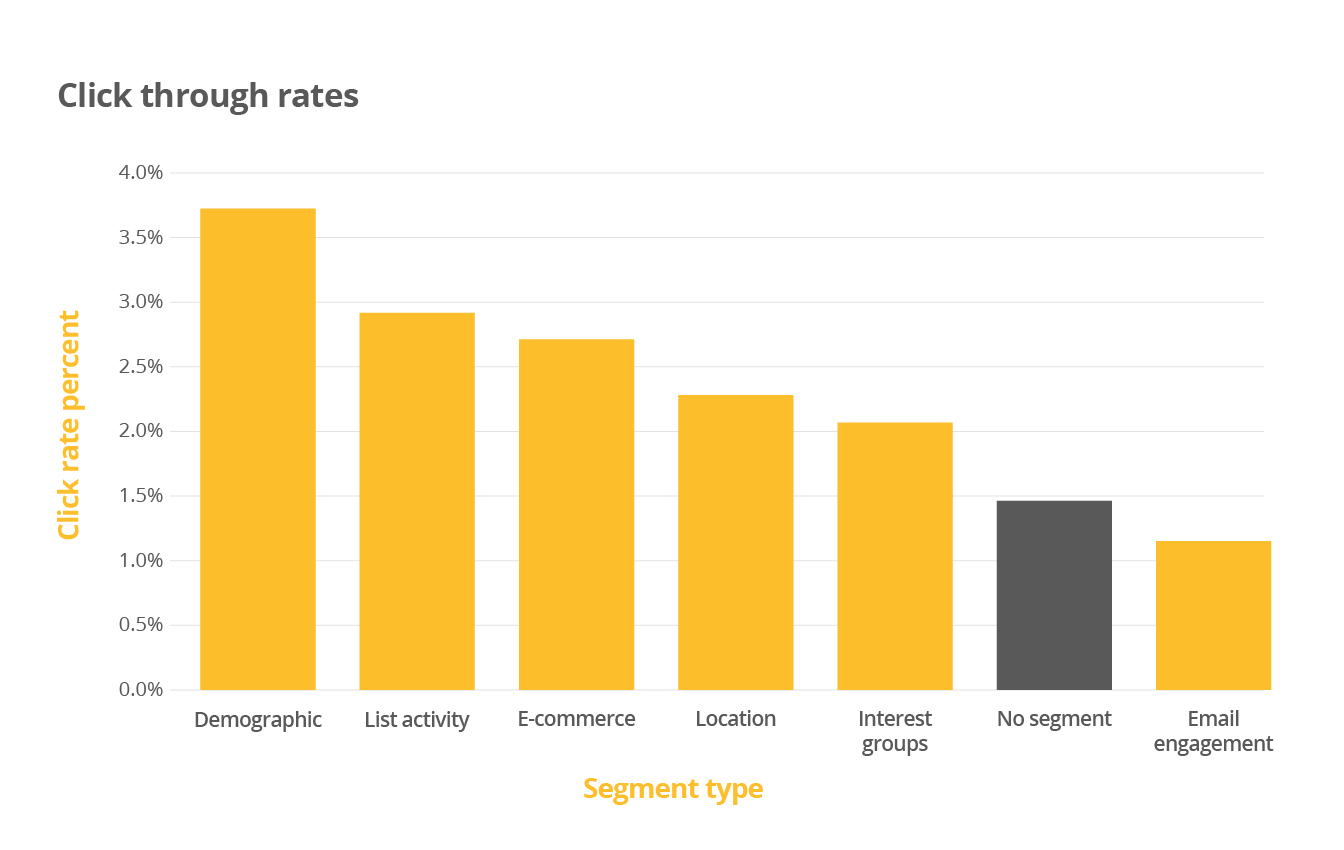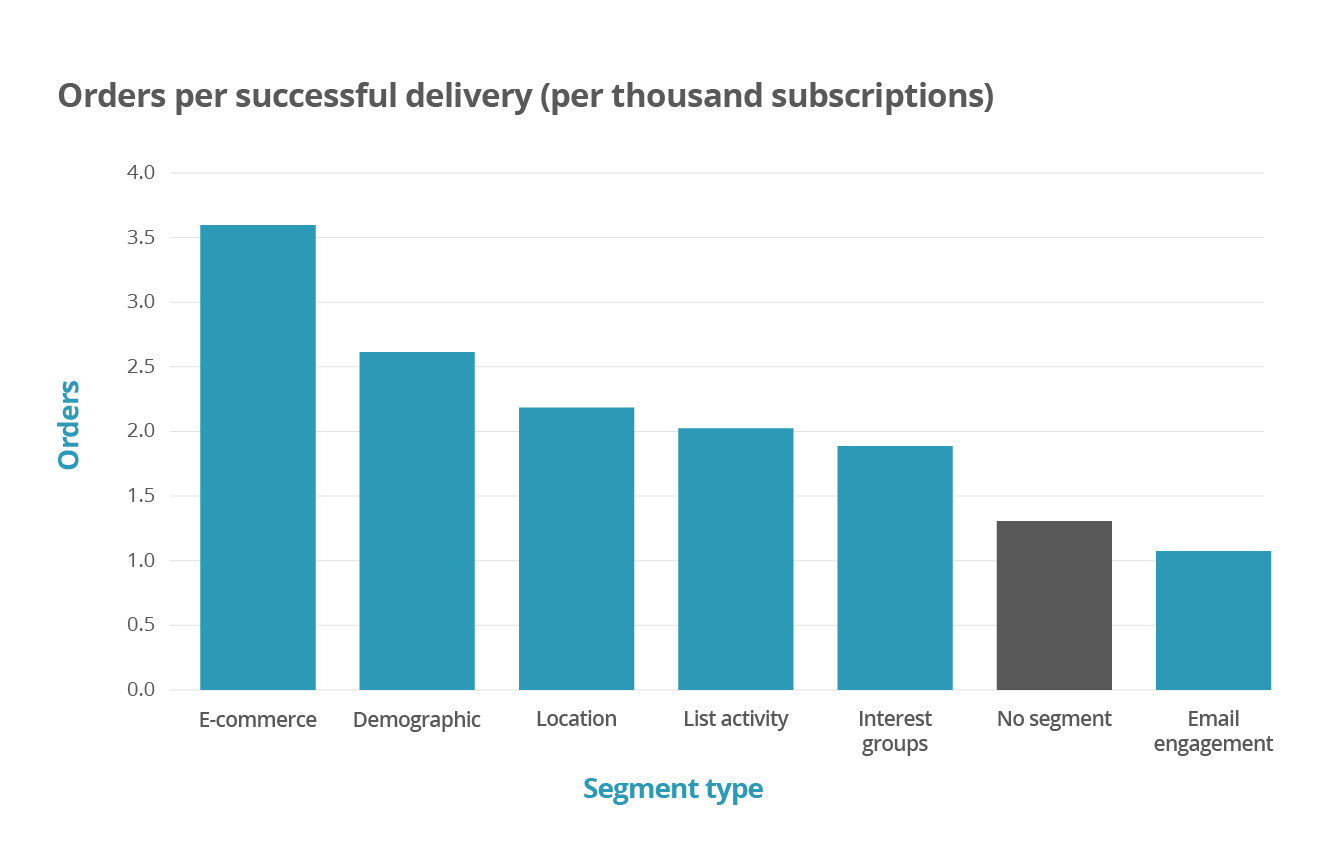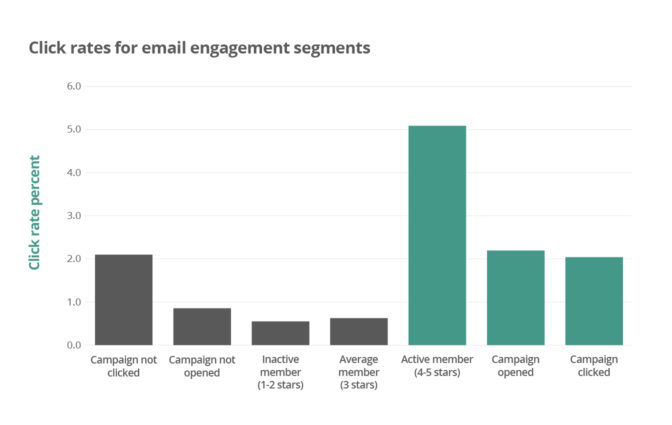MailChimp’s list segmentation is a powerful tool that allows campaigns to be sent to targeted segments of subscribers. These segments can be based on interest groups, demographic data, e-commerce activity, and other subscriber data. While segmenting isn’t necessary for every campaign, it can significantly increase 2 important campaign success metrics: click-through rates and e-commerce orders generated. Our past research indicates that click rates in campaigns tend to be under 3%, so even 1/10 of a percent improvement can mean substantially more store visits and additional orders.
Our research team considered regular campaigns sent during the second half of 2016, then determined which type of segment each campaign used, including none. We used the median rate for each metric to avoid bias from outliers that were extremely low or high.
Before we get started, here are our definitions of the different segmentation types mentioned:
- Demographics segments use MailChimp’s Predicted Demographics tool to predict a subscriber’s age, language, and gender. You can target users with personalized content using these types of pre-built segments in order to increase engagement.
- E-commerce segments are based on data from the list’s connected e-commerce store and can increase sales with existing or lapsed customers (and possibly engage potential customers). This segment type has several options, including specific items or item categories purchased, dollar amounts, purchase dates, and well as customer status. Pre-built options for customer status like lapsed, first-time, or potential customers are also included.
- Email engagement segments are based on interactions with campaigns, like who did or didn’t open or click a campaign. This includes subscriber data about campaign and automation activity and member ratings, as well as pre-built segments for subscriber activity. These segments are often used to follow up on previous campaigns or to re-engage subscribers with lower activity ratings.
- Interest group segments are created from the interests and preferences subscribers choose when signing up to a list or when they update their profile. Groups are great tools for making sure subscribers are getting content that they will engage with—or letting them choose how frequently they would like to receive emails from you.
- List activity segments are based on list changes, such as when a subscriber signed up to the list or updated their profile, as well as their signup source location—like MailChimp’s hosted form, Facebook, or connected e-commerce sites. These segments could be used to target newer subscribers with recent campaigns, or to send an online coupon offer to thank subscribers for visiting and subscribing through your Facebook page.
- Location segments use each subscriber’s geolocation data to target a specific geographic region with a campaign. For example, you might want to target non-local customers with a special shipping deal and send it at a time appropriate for their time zone using TimeWarp.

For both of our metrics (click rate and e-commerce orders), we found that most of the segmented campaigns performed better than those without segmentation. For instance, median click rates for segmented campaigns improved by up to 2%. Email engagement is the exception, and we’ll dig into that below.

Based on the second metric, orders per thousand successful deliveries, we see that segmented campaigns led to selling more stuff than those without segments (but again, email engagement suffered). The e-commerce segment types outperformed no segments by almost 3 times as many sales per subscriber.
For both the click rate and e-commerce orders metrics, demographic segments had a healthy 3.5% click rate and 2.5 orders per thousand subscribers.

The one exception in both of our success metrics is the email engagement segment, which performed worse than campaigns using no segments at all. This segment type can include inactive subscribers (those who had not clicked, opened, or otherwise interacted with previous campaigns), so it makes sense that these campaigns might not fare as well. We confirmed that hunch when we found that click rates for most of the inactive segment types had only half that of the active subscriber segments as shown in the chart above (gray bars are inactive segments, green are active).
At first glance, the small click rates for the less active subscriber segments appear to render those types useless. But remember that it may be less expensive to target a past customer than it is to find a new one, and winning back the interest of inactive subscribers with a re-engagement campaign helps you make the most of your list.
List segments can also be used with MailChimp’s new Facebook Ad Campaigns. The success of both your segmented email and Facebook campaigns can be tracked through the Reports page of your account. Email campaign data and e-commerce tracking can also be found on the account dashboard when you log in.
There will, of course, be cases when you would want to send a campaign to everyone on a list. For example, you would certainly want all of your customers to know if your online shop’s URL had changed, or if you’re announcing a giveaway on your site. But for most campaigns, it’s wise to send smaller, segmented campaigns with content personalized to those subscribers. Happy segmenting!



